Integrating QR codes into various media forms has significantly enhanced user interactivity and engagement. Among these applications, using QR codes on books is a particularly innovative approach.
This blog post will explain using QR codes on books, providing a fresh perspective on how we interact with books and the myriad benefits this technology brings. Let's begin!
What is a Book QR Code?
At its core, a book QR code is a digital gateway embedded within the pages of a book or on its cover, designed to enhance the reader's experience by seamlessly connecting them to additional digital content.
This content could range from author interviews, supplementary research, and interactive elements to exclusive offers, all accessible with a simple scan using a smartphone or tablet.
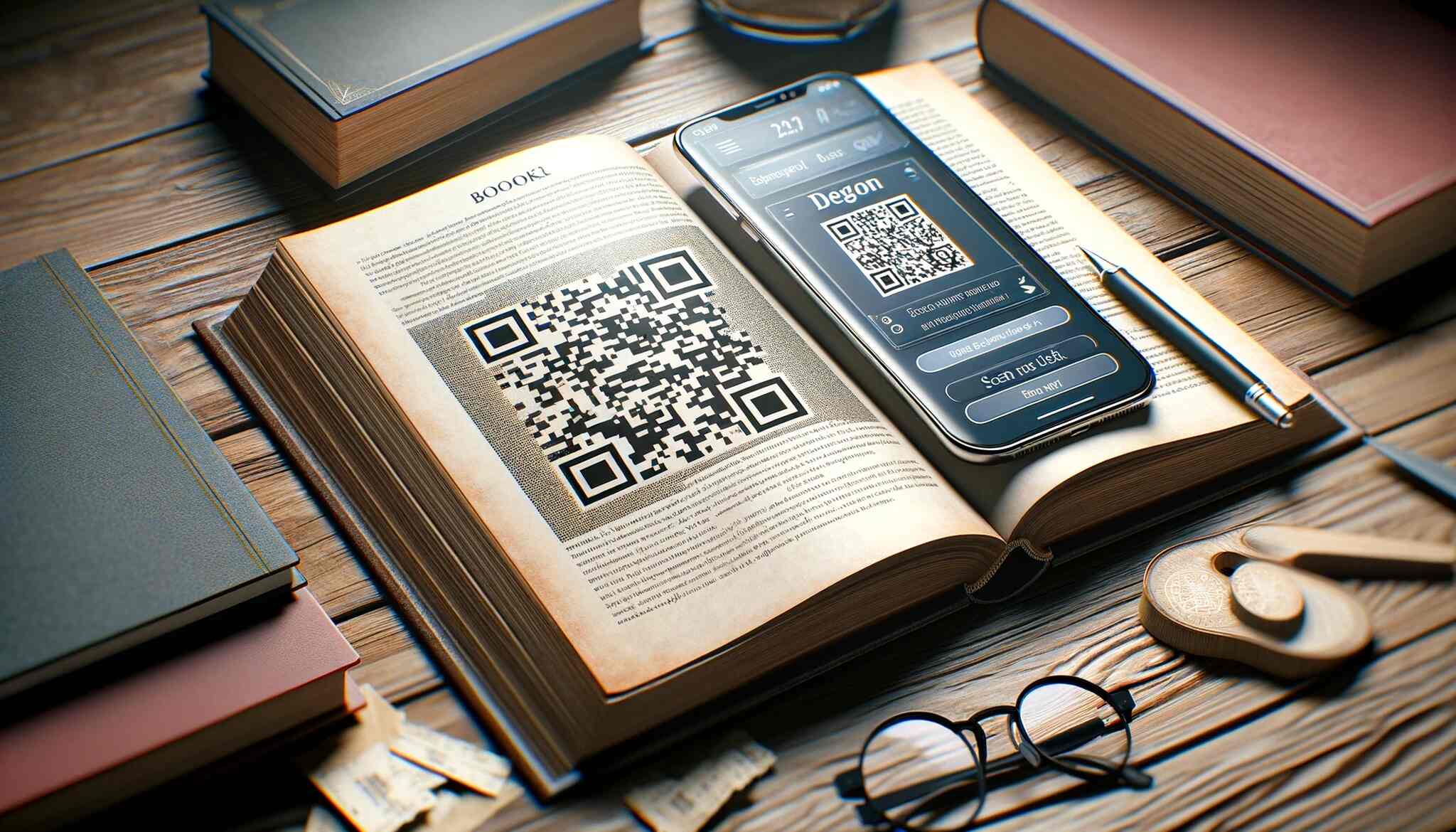
The purpose of incorporating QR codes into books is multifaceted:
- Enhanced Engagement: They offer an interactive layer to the reading experience, making it more engaging and immersive.
- Extended Content: QR codes provide the means to extend the narrative or educational content beyond the physical pages, offering a deeper dive into the material.
- Marketing and Promotion: For authors and publishers, QR codes serve as a powerful marketing tool, allowing them to connect with readers on a new level, promote related content, and even track reader engagement and preferences.
- Educational Enhancement: In academic settings, QR codes can link to additional study materials, video lectures, or interactive tests, enriching the learning experience.
How to Create a Book QR Code?
Incorporating QR codes into your book doesn't have to be daunting. With platforms like QR Code Dynamic, it's easier than ever to create, manage, and track the performance of your QR codes.
Whether you're looking to link to additional resources, exclusive content, or interactive features, follow these steps to create a QR code that enhances your book's value and engages your readers on a whole new level.
Step 1: Define Your Goal
Before diving into the technical aspects, it's crucial to clearly understand what you aim to achieve with your QR code.
Are you looking to provide additional content, direct readers to a website, or offer an interactive experience? Defining your goal will guide the content you link to and the type of QR code you create.
Step 2: Sign Up and Navigate the Dashboard
For this guide, we'll use QR Code Dynamic, which is known for its ease of use and dynamic QR code capabilities.
Dynamic QR codes are especially beneficial for books because they allow you to update the linked content without changing the QR code itself – perfect for keeping your book's content fresh and engaging.
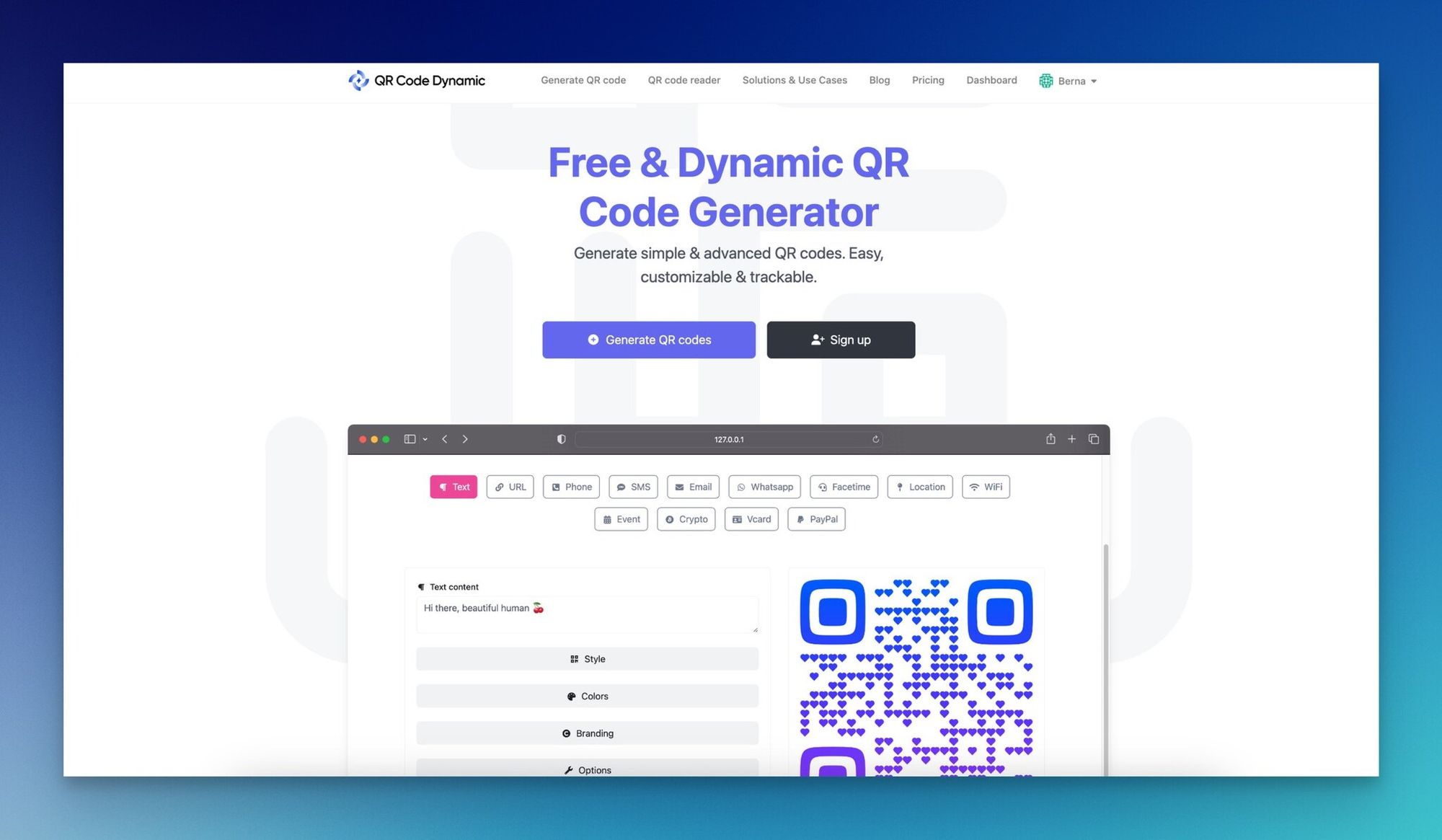
Visit QR Code Dynamic's website and sign up for an account.
Step 3: Create a New QR Code
Click on the "Generate QR Codes" button. You'll be prompted to select the type of content you want your QR code to link to.
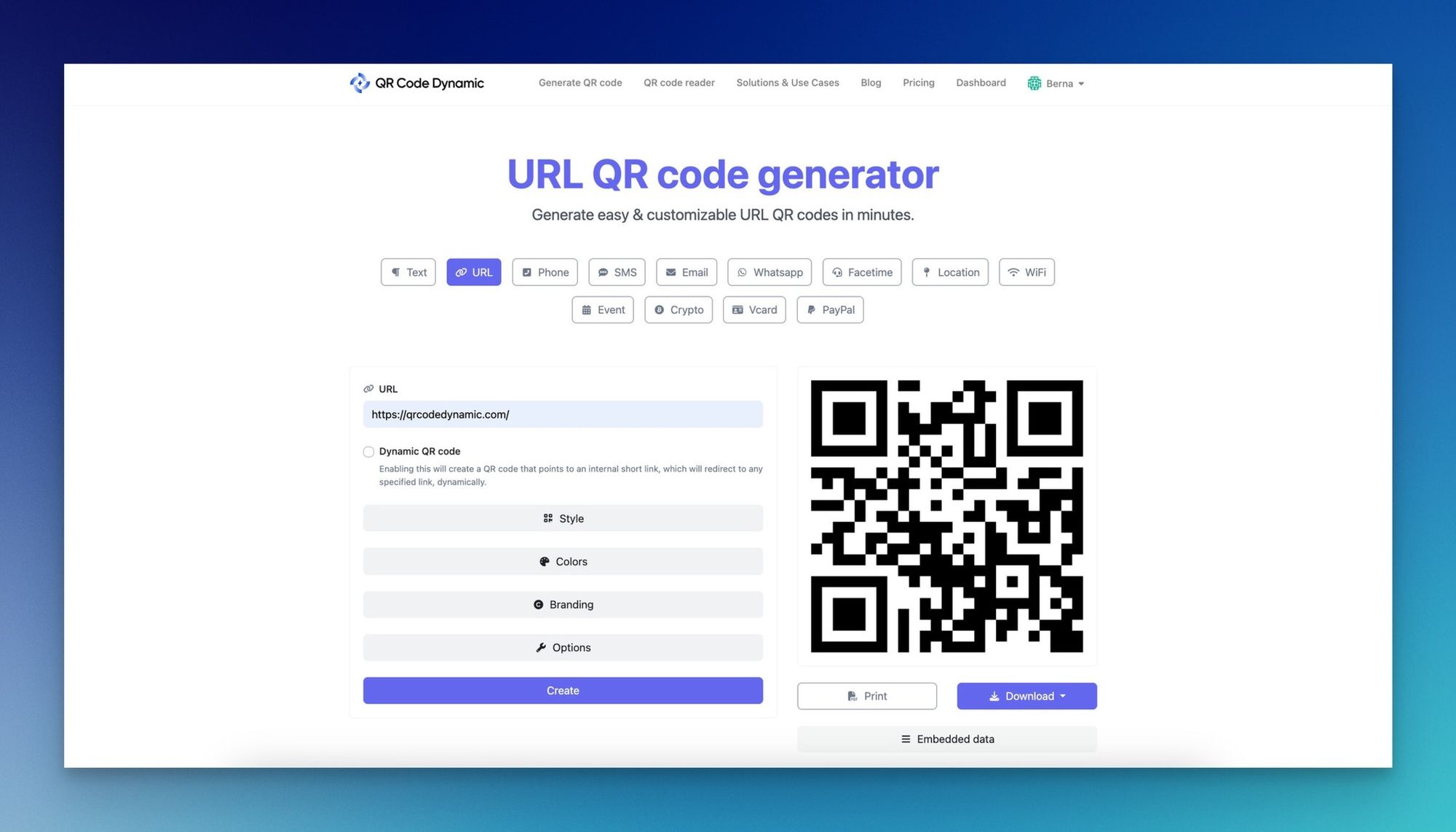
QR Code Dynamic offers various options, including URLs, texts, locations, and more. Choose the one that aligns with your goal. Enter the information you want to display in the input field.
Step 4: Customize Your QR Code
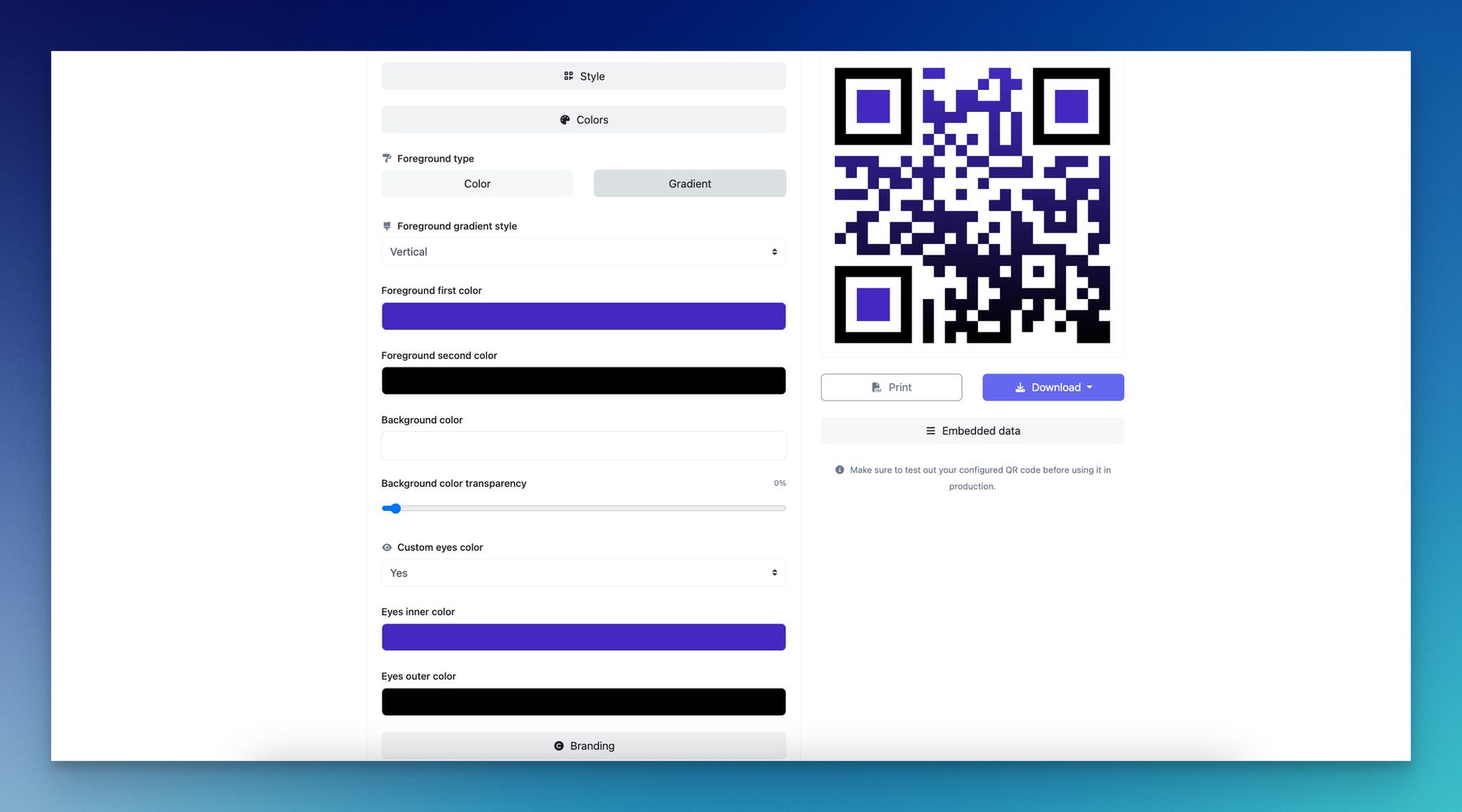
After selecting the content type, it's time to customize your QR code. Customize the appearance of your QR code to match your book's design. You can choose colors and patterns and even add a logo to make it uniquely yours.
Once you finish it, click the "Create" button to create your QR code.
Step 5: Test Your QR Code
Before printing, it's essential to test your QR code. Use multiple devices and QR code scanning apps to ensure they work correctly and lead to the intended content. This step is crucial to avoid any disappointments or confusion for your readers.
Step 6: Integrate the QR Code into Your Book
Once tested, it's time to place your QR code in your book.
Consider the following for optimal placement:
- Visibility: Ensure the QR code is easily visible and accessible for scanning. Common placements include the back cover, book flaps, or within relevant chapters.
- Context: Provide a short explanation or call-to-action near the QR code, guiding readers on what to expect and how to scan it.
- Design: The QR code should complement the book's overall design and not disrupt the aesthetic or reading experience.
Step 7: Publish and Promote
With your QR code in place, proceed with publishing your book. Promote the added value of the QR code in your marketing efforts, highlighting the exclusive content or experiences it unlocks for readers.
Step 8: Track and Analyze Performance
One of the advantages of using QRCodeDynamic is the ability to track your QR code's performance.
By using dynamic QR codes, you can track the performance of your book QR codes.
Use the platform's analytics tools to gain insights into how often the QR code is scanned, where your readers are located, and what devices they use. This data can be invaluable for understanding reader engagement and planning future projects.
Step 9: Update and Iterate
The dynamic nature of your QR code means you can update the linked content based on feedback, new developments, or additional resources you want to share. This keeps your book relevant and engaging long after its publication.
Why Use QR Codes on Books?

Embedding QR codes in books opens up a new realm of possibilities for authors, publishers, and educators, allowing them to connect with readers dynamically.
Below, we delve into the compelling reasons for incorporating QR codes into books.
Engaging Readers in New Ways
QR codes in books offer an innovative avenue to deepen reader engagement.
- Interactive Features: QR codes can link to interactive maps, animated illustrations, or augmented reality experiences that bring the book's content to life.
- Behind-the-Scenes Insights: Authors can share insights into their writing process, research, or the inspiration behind their work, creating a deeper connection with their audience.
- Community Building: By linking to social media discussions or book club questions, QR codes can foster a sense of community among readers, encouraging discussions and shared experiences.
Dynamic Interaction for Educational Purposes
In the realm of educational publishing, QR codes serve as a powerful tool to enhance learning and access to resources.
- Supplementary Resources: QR codes can provide instant access to additional reading materials, video lectures, or external research, enriching the educational content.
- Interactive Learning: Educators can link to interactive quizzes, simulations, or experiments, making learning more engaging and effective.
- Instant Updates: Dynamic QR codes allow for the content to be updated or expanded, ensuring that educational materials remain current and relevant.
Innovative Marketing for Authors and Publishers
For authors and publishers, QR codes are not just a tool for engagement but also a potent marketing instrument.
- Direct Promotion: QR codes can link to the author's website, upcoming events, or promotional offers, driving sales and building a loyal readership.
- Analytics and Feedback: By tracking the scans, authors and publishers can gain valuable insights into reader preferences, engagement levels, and the effectiveness of marketing strategies.
- Sample Chapters and Previews: QR codes can provide sneak peeks of upcoming books or exclusive content, enticing readers and building anticipation for new releases.
Enhanced Accessibility

QR codes in books can significantly improve accessibility, making content more inclusive for readers with disabilities or those who prefer multimedia formats.
- Audio Versions: QR codes can link to audio narrations of the book, benefiting visually impaired readers or those who enjoy audiobooks.
- Translations and Transcriptions: They can provide access to translations or transcriptions of the book, catering to a broader, more diverse audience.
- Easy Navigation: For large or complex works, QR codes can help readers navigate to specific chapters, appendices, or indices, enhancing usability.
Environmental Benefits and Cost-Effectiveness
Incorporating QR codes into books can also have environmental and cost benefits.
- Reduced Paper Use: Linking to digital content reduces the need for supplementary printed materials, contributing to sustainability efforts.
- Cost Savings: Digital distribution of additional content via QR codes can be more cost-effective than printing, especially for small publishers or independent authors.
- Flexibility and Scalability: Digital content linked through QR codes can be scaled and updated without incurring additional printing costs, making it an economical choice for expanding book content.
How to Use QR Codes on Books
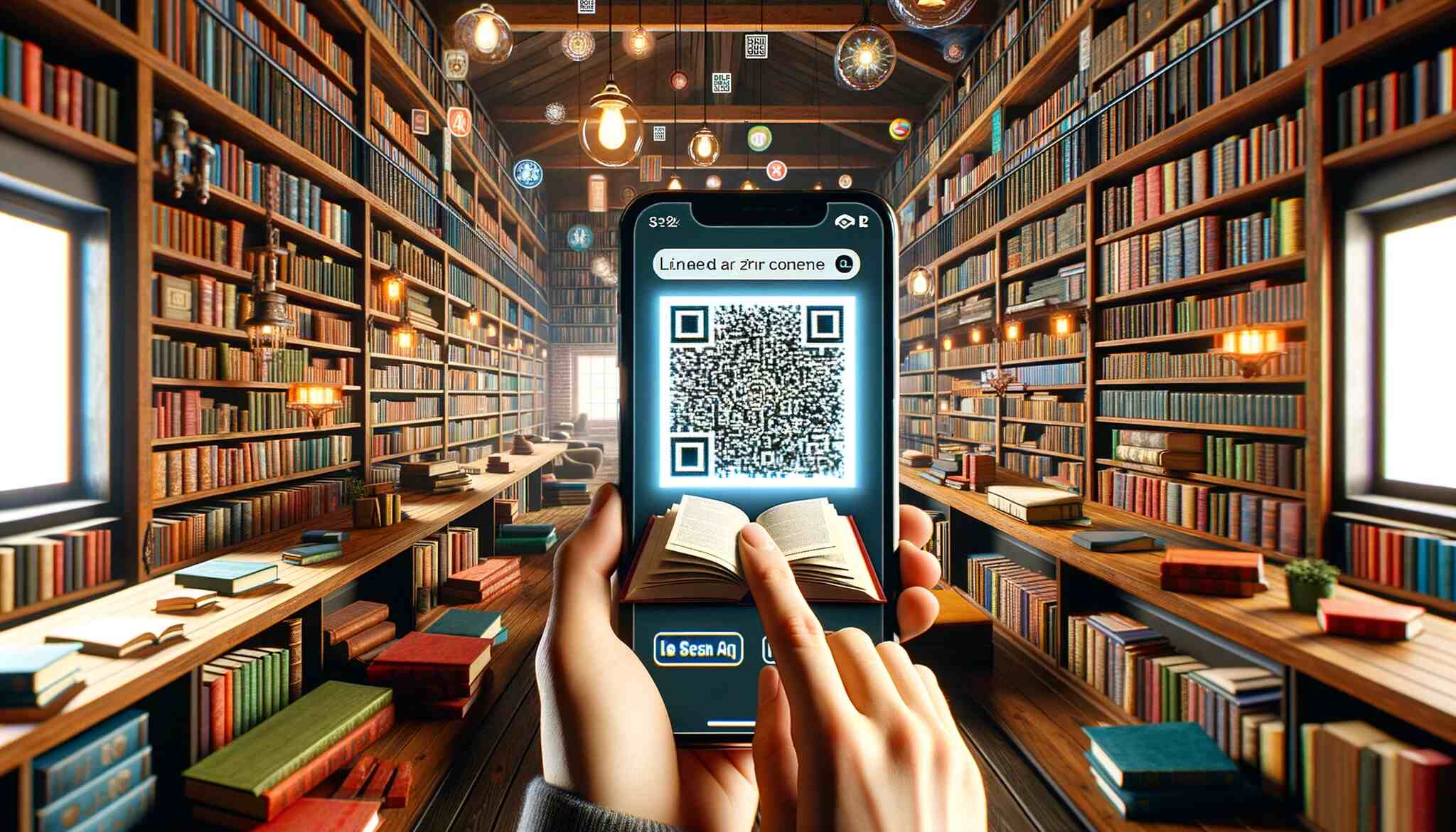
The strategic use of QR codes can transform ordinary books into interactive platforms, providing readers with access to a wealth of additional content.
From enhancing the narrative with multimedia elements to offering educational resources, the potential applications are vast.
Here's how to harness the power of QR codes in your publications.
Strategic Placement for Maximum Engagement
The placement of QR codes within your book can significantly impact their effectiveness. Consider these strategies for incorporating QR codes in a way that complements the content and entices readers to engage:
- Front or Back Cover: Placing a QR code on the cover can immediately grab attention and can be used to link to trailers, author interviews, or promotional materials.
- Chapter Headings: Embed QR codes at the beginning of chapters to provide readers with supplemental information and interactive content related to the chapter's theme or to engage with multimedia storytelling.
- Margins or Footnotes: For educational or non-fiction books, QR codes can be subtly placed in the margins or footnotes, linking to further readings, research papers, or explanatory videos.
- End Pages: Utilize the end pages of your book for QR codes that direct readers to your website, social media profiles, or a signup page for your newsletter, fostering ongoing engagement.
Creating Context Around QR Codes
To ensure that readers understand the purpose of each QR code and feel compelled to scan it, provide clear, concise context for each code:
- Brief Descriptions: Accompany each QR code with a short description or call-to-action, explaining what readers will gain by scanning it, such as "Scan for a behind-the-scenes look at the making of this book."
- Engaging Calls-to-Action: Use action-oriented language to encourage scans, such as "Discover the story," "Join the discussion," or "Access bonus content."
- Visually Appealing Design: Ensure that the QR code and its accompanying text are visually integrated into the page, using fonts, colors, and design elements that match the book's overall aesthetic.
Enhancing the Reading Experience with Multimedia Content
QR codes can link to a variety of multimedia content, significantly enriching the reading experience. Here are some creative ways to use QR codes for different types of books:
- Fiction: Link to author commentary, character backstories, location maps, or even a soundtrack that complements the story.
- Non-Fiction: Provide access to extended interviews, documentary footage, datasets, or interactive infographics that deepen the reader's understanding of the subject.
- Educational Materials: Link to online quizzes, supplementary reading materials, video tutorials, or interactive modules that reinforce learning objectives.
- Children's Books: Use QR codes to include animated stories, read-along audio, or interactive games that make learning fun and engaging.
Using Book QR Codes for Marketing and Community Building
QR codes can also serve as powerful marketing tools, helping authors and publishers connect with readers and build a community around their books:
- Exclusive Offers: Use QR codes to offer discounts on future purchases, access to exclusive content, or entry into giveaways, incentivizing readers to engage with your brand.
- Social Media Engagement: Link to social media profiles or hashtags related to your book, encouraging readers to share their thoughts and connect with other readers.
- Feedback and Reviews: Direct readers to a platform where they can leave feedback or reviews, providing valuable insights and boosting your book's visibility.
Best Practices for Implementing QR Codes on Books

The successful implementation of QR codes in books hinges on thoughtful planning, design considerations, and understanding the reader's needs and expectations.
By adhering to these best practices, you can create a seamless and enriching experience that elevates your book beyond its physical pages.
Strategic Content Linking
- Relevant and Valuable Content: Ensure that the content linked via QR codes is directly relevant to the book's material and offers real value to the reader.
- Dynamic Content: Utilize dynamic QR codes to keep the linked content fresh and updated. This allows for the content to evolve over time, offering readers new insights or related material long after the book's publication.
Design and Placement
- Integration with Book Design: QR codes should complement the book's overall design and not detract from its aesthetic. Carefully consider QR codes' size, placement, and appearance to ensure they blend seamlessly with the page layout and design elements.
- Strategic Placement for Maximum Impact: Place QR codes at strategic points within the book where they are most likely to engage the reader. This could be at the end of chapters, within sidebars, or in sections where multimedia content can enhance understanding or enjoyment.
- Clear Instructions: Provide clear, concise instructions on how to use the QR codes, especially if you're targeting an audience that may be less familiar with the technology. A brief explanation of what the QR code links to and how to scan it can significantly increase engagement.
Enhancing Reader Experience
- Interactive Engagement: Use QR codes to turn the reading experience into an interactive journey. Link to videos, audio clips, interactive maps, or augmented reality experiences that bring the book's content to life.
- Exclusive Content: Offer exclusive content through QR codes to make readers feel special and valued. This could include behind-the-scenes looks, author interviews, or bonus chapters that aren't available elsewhere.
Quality and Testing
- High-Quality QR Codes: Ensure that the QR codes are high-quality and easily scannable. Poorly printed or low-resolution QR codes can frustrate readers and disengage them.
- Comprehensive Testing: Test the QR codes with various devices and QR scanning apps to ensure compatibility and ease of use. Consider factors such as print size, contrast, and the scanning environment to guarantee a smooth user experience.
Security and Privacy
- Secure Links: Always link to secure, trusted websites to protect your readers from potential security threats. Utilize HTTPS protocols and regularly monitor the linked content for any security issues.
- Transparency about Data Collection: If any personal data is collected through the use of QR codes, be transparent with your readers about what is collected and how it will be used. Respect privacy and adhere to data protection regulations.
Accessibility and Inclusivity
- Consider Accessibility: Ensure that the content linked through QR codes is accessible to all readers, including those with disabilities. Provide alternative text descriptions and audio versions of visual content and ensure that websites and digital content comply with accessibility standards.
- Inclusive Content: Be mindful of creating inclusive content and considerate of a diverse audience. Ensure that the content linked via QR codes respects cultural sensitivities and is accessible to a broad range of readers.
Feedback and Iteration
- Encourage Reader Feedback: Use QR codes to gather feedback from your readers about their experience with the book and the QR code content. This can provide valuable insights for future projects and help you better understand your audience's needs and preferences.
- Iterate and Improve: Based on reader feedback and engagement data, continually refine and update the content linked through QR codes. This iterative process ensures that your book remains relevant and engaging, even in a rapidly changing digital landscape.
Conclusion
Integrating QR codes into books is an exciting venture into the fusion of traditional reading and digital innovation. These tiny, scannable gateways open up a world of interactive possibilities, enriching the reader's experience with layers of additional content, insights, and engagement.
Whether you're an author, publisher, or educator, embracing the power of QR codes can transform your books into dynamic platforms of discovery and connection.
Frequently Asked Questions
How can QR codes enhance the reading experience?
QR codes can transform reading into an interactive experience by linking to multimedia content, providing deeper insights into the book's subject matter, enabling direct engagement with the author or community, and offering educational resources that complement the text.
Where should QR codes be placed in a book?
QR codes can be effectively placed on the front or back cover, at chapter headings, within margins or footnotes for educational texts, or on end pages. The key is to ensure visibility and relevance to the accompanying text or content.
Are dynamic QR codes better for books?
Yes, dynamic QR codes are preferable for books because they allow you to update the linked content without needing to change the QR code itself. This flexibility ensures that the content remains relevant and up-to-date, extending the life of your book.
How can I ensure readers use the QR codes?
To encourage readers to scan QR codes, provide clear instructions and context for each code, ensure the linked content is engaging and adds value, and make sure the QR codes are easily visible and accessible within the book's layout.
Can QR codes be used for marketing books?
QR codes are a powerful marketing tool for books. They can link to promotional materials, author websites, social media profiles, and special offers, helping to drive engagement, build a reader community, and promote sales.
Visit our latest blog posts:


